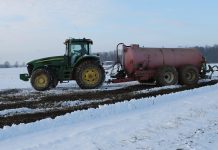We are starting to see the full crop response to the dry weather as yield and test weights are measured. Excluding a few counties near Lake Erie, most of Ohio continues to see severe drought.
Some of my colleagues dubbed the areas around Lake Erie “Ohio’s garden spot” due to the amount of rain they received. Drought conditions increase in a continual gradient as you continue south. Crop quality and yields appear to be following this same gradient.
Ashtabula County received several rains — some very heavy — this summer resulting in near-normal soil moisture conditions.
Due to this, most of the county was never part of the drought map for the state. The rain they experienced provided moisture at the critical point for corn pollination and then again for soybean fill.
However, disease pressure was slightly higher there than in surrounding areas as moisture provided favorable environments for white mold in soybeans and northern corn leaf blight in corn. The rest of the state experienced relatively low disease pressure compared to previous years.
Here in Trumbull County, we had much less rain. Much of the county was in a D0 to D2 drought during the growing season, according to the U.S. Drought Monitor. While I was scouting soybean fields in September, I saw many plants with few pods and many pods with only one or two beans. Based on this, I was expecting to see lower-than-average yields.
However, soybean harvest is fast approaching 75% completion and I am hearing reports of record yields with some field averages of 80+ bushels per acre.
What could drive soybean yields so high in such an exceptionally dry year? It is not likely one factor, but a combination of low disease pressure, improving plant genetics for drought resistance, perfectly timed rain and other factors all aligning for a good soybean yield. Historically, white mold has been a serious yield-limiting disease, but the dry weather slowed it this year. You can still find pockets of white mold in the fields, but the infected plants still have harvestable beans, which mitigates any yield loss.
Rain showers in August and September arrived at critical plant growth stages and had a positive impact even though they provided less rain than in normal years. All these factors make this a unique situation, and it may take hundreds of years to replicate this scenario.
These high yields we are experiencing locally in Northeast Ohio start to drop rapidly as you continue further south. Soybean yields of less than 20 bushels per acre are common in areas hardest hit by the drought. The overly dry conditions are also resulting in quality issues including germination in the pod, cracking beans, discolored hilum and very low test weights. Farmers are scrambling to find outlets for these low-quality beans as elevators are rejecting these loads.
It will be difficult to use information from this year to make seed selections for next year. With average rainfall, a soybean variety may have produced average yields or above-average yields, but we can’t know its potential because of the drought.
On the other hand, a seed that produced well in this year’s unfavorable conditions may have faltered in a year within normal disease pressure. The foundation for disease resistance, drought tolerance and yield are all rooted in your crop’s genetics.
Unlike disease or pests, which usually infect a few fields at a time, drought was present in every field, allowing for better visualization of how genetics can influence crop success. Driving down a single road, you can see some corn doing fairly well and other corn barely chest high. A reliable approach for seed selection would be to stay the course using genetics that historically succeeded on your farm, knowing that this year was unusual.













